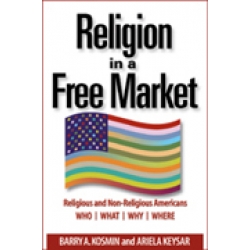Religion in a Free Market by Barry A. Kosmin and Ariela Keyser
|
"Religion in a Free Market by Barry A. Kosmin and Ariela Keyser"
Religious and Non-Religious Americans, Who, What, Why, Where -- A report on the ARIS 2001 Survey |
|
| Price: | $49.95 |
| Availability: | In Stock |
| Item #: | 1032 |
| Author: | Kosmin, Barry and A. Keysar |
| Average Rating: | Not Rated |
By Barry A. Kosmin and Ariela Keyser
The success of American religion, its amazing vitality and dynamism, is due to the free market-oriented regime under which it has operated for over two centuries. The market system allows generations and groups to seek different responses to their spiritual and religious needs.
The American Religious Identification Survey (ARIS) reported in depth in this book is the most comprehensive survey of religion ever done in the United States. Over 50,000 Americans were asked to report on their religious affiliations, outlook, beliefs, and their responses were weighted to reflect the entire U.S. population. (A 2008 version of the survey was released in March 2009. For more information, see www.americanreligionsurvey-aris.org).
Whatever you learned about religion in the U.S. a generation ago is out of date. Whether you are a political consultant, a marketer, a religious leader, or a social scientist, it is impossible to understand America without understanding religion in America. According to ARIS 2001, 75 percent of adults said they religious or somewhat religious and 91 percent said they believe in God. Even those who consider themselves secular—a rapidly growing proportion of the public—are acutely aware of and influenced by the religious milieu surrounding them.
Here are some findings of the ARIS survey which are reported in-depth in Religion in a Free Market:
- America remains primarily a Christian society at the beginning of the 21st century. However, the share of the population that self-identifies with a Christian tradition declined from 86.2 percent in 1990 to 76.5 percent in 2001.
- The share of American adults who say they have no religion rose frm 8 percent in 1990 to 14 percent in 2001—representing almost 30 millino people.
- As of 2001, 16 percent of American adults had switched religious identification at some point in their lives. Catholicism was the biggest "loser" and "no religion" the biggest "gainer."
- The mobility of American society has done little to erode strong regional religious cultures such as those of the Catholics of the Northeast, the Lutherans of the Upper Midwest, the Baptists of the South, and the "Nones" of the Pacific Northwest.
- Despite popular impressions of religiously engaged youth, in general the old and middle-aged are mroe likely than the young to believe in God and identify with a religious group.
Contents
Chapter 1 American Religion, Religious Brands, and Markets
Chapter 2 The National Profile of Religious Identification in the United States
Chapter 3 Belief, Belonging, and Behavior
Chapter 4 Religious Switching
Chapter 5 Who are the Religious and Non-Religious
Chapter 6 Household and Family Characteristics
Chapter 7 Geographic Distribution of Religions
Chapter 8 Gender and Socioeconomics
Chapter 9 Socioeconomic Rankings
Chapter 10 Patterns of Consumption of Modern Technologies
Chapter 11 Religious Affiliation and Recruitment
Chapter 12 Membership Patterns Among Specific Religious Groups
Chapter 13 Religion and Political Party Preference
Chapter 14 Race and Ethnicity in Religious Identification
Chapter 15 Profile of the American Muslim Population
Chapter 16 Current and Future Trends
(320 pp., hardcover, ISBN 978-0-9766973-6-7; 2006)
Your Review: Note: HTML is not translated!
Rating: Bad Good
Enter the code in the box below:







